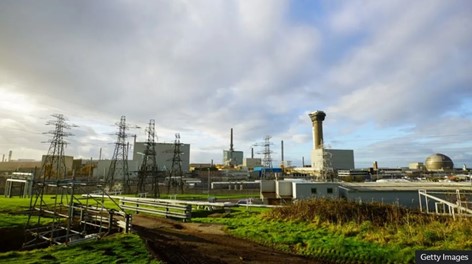
UK Faces Urgent Challenge in Managing Nuclear Waste
Sellafield, located in Cumbria, is one of the world's most hazardous nuclear sites, temporarily storing the vast majority of the UK's radioactive waste and the world's largest stockpile of plutonium. As the site fills up and concerns about its security grow, experts warn that a permanent solution for nuclear waste storage is desperately needed. The government's plan to expand nuclear power as part of its "clean power by 2030" strategy will only add to the problem, generating more radioactive waste that remains hazardous for 100,000 years.
Sellafield's operations involve handling and storing used nuclear fuel, a complex process carried out 24/7 by a workforce of 11,000. Despite its critical role, the site has faced security breaches, aging infrastructure, and questions about its safety culture. One of its oldest waste storage silos, built in the 1960s, is leaking radioactive liquid, a reminder of the site's long history dating back to the Cold War when it was a hub for plutonium production.
The UK's long-term solution to managing nuclear waste involves burying it deep underground in a Geological Disposal Facility (GDF), where it will be locked away in solid rock. However, finding a suitable location has proven challenging. The search began six years ago, with communities in England and Wales invited to express interest in hosting the facility. While five areas came forward, only three remain under consideration: Mid Copeland and South Copeland in Cumbria, and a site in Lincolnshire. Geologists are now testing these locations for the right rock formations, and local communities are being consulted in a process that could take over a decade.
Local support is critical for the project to move forward, and financial incentives have been offered to communities participating in the discussions. Each of the shortlisted areas receives £1 million annually to support local investment during the early stages of consultation and geological testing. However, opposition remains strong, particularly in Lincolnshire, where residents have staged protests against the facility.
David Moore, a councillor from Seascale, near Sellafield, argues that his community is already the de facto host for the UK's nuclear waste and believes a safer, permanent solution is essential. "I want my grandchildren to live in a safe environment," he says. Yet, not all communities share this view. In Lincolnshire, anti-nuclear campaigners argue that the government's consultation process is flawed and that local voices may not be adequately heard.
While countries like Finland and Switzerland are already moving forward with their GDFs, the UK's facility is not expected to be operational until the 2050s. Until then, Sellafield will continue to store and manage the waste.
Experts like Professor Claire Corkhill emphasize that finding a permanent solution is essential for both the future of nuclear energy and the safety of future generations. "We've benefited from nuclear power for 70 years, but we're still far from cleaning up the waste left behind," she says. As the UK looks to expand its nuclear power capacity, it must also face the challenge of managing the radioactive waste it produces.